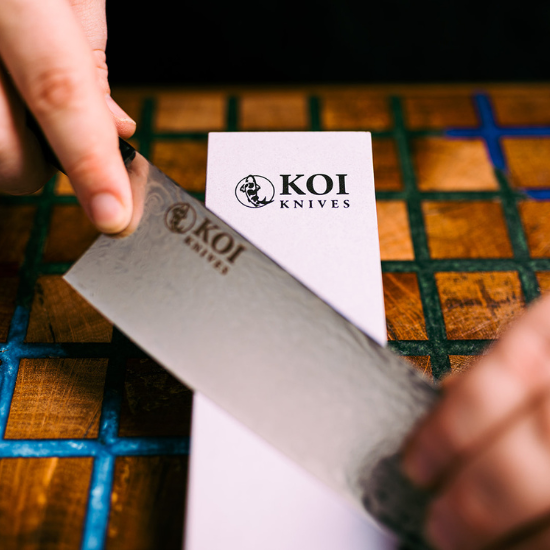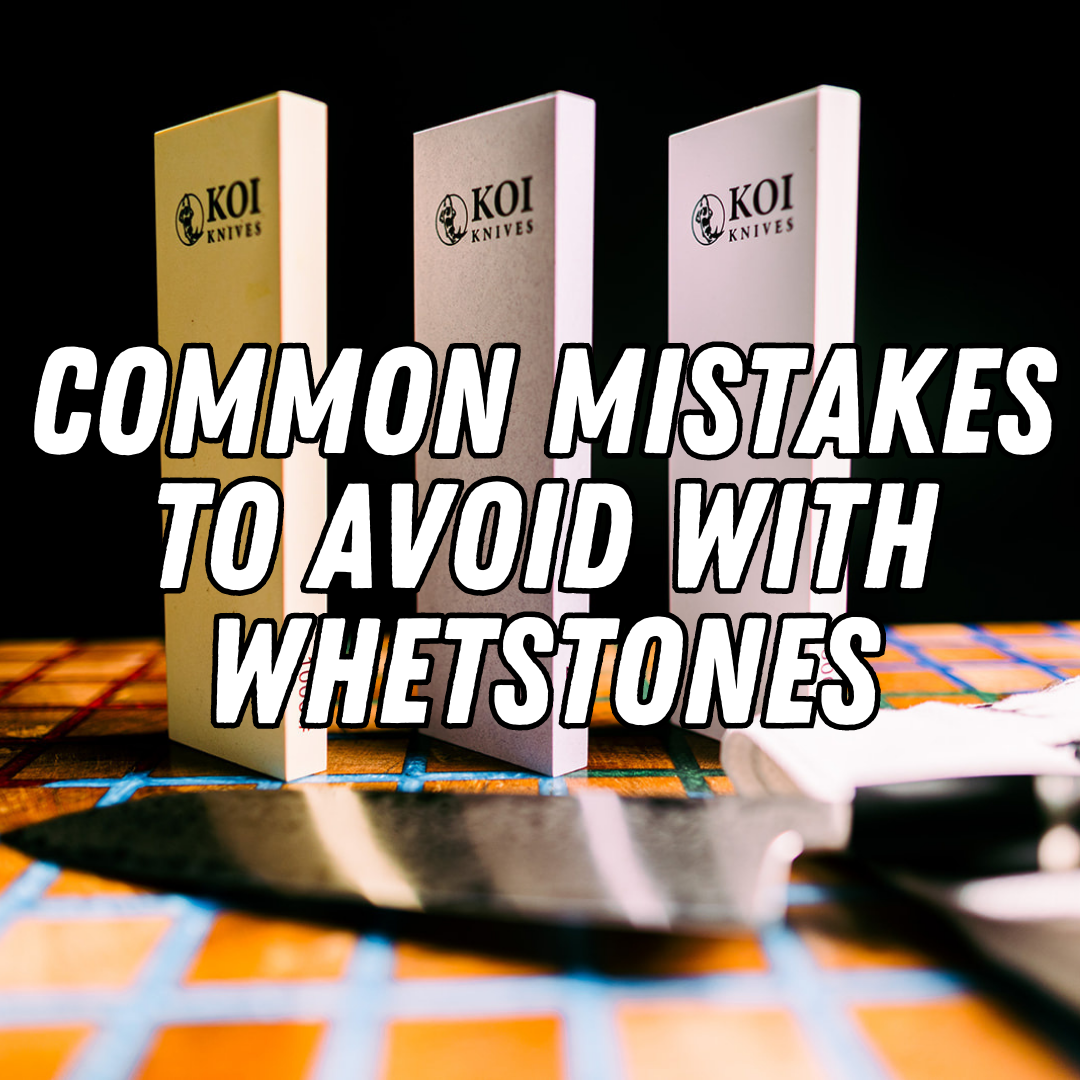Knife sharpening is an art, a science, and a necessity. When it comes to Koi knives, these exquisite blades deserve special attention. Their unique construction demands precision and care to maintain their extraordinary cutting edge. In this post, we will look at the secrets of sharpening Koi knives.
We'll explore the tools, techniques, and the distinctiveness of Koi blades. Whether a culinary lover or a skilled chef, this knowledge will elevate your culinary experience and keep your Koi knives sharp.
Understanding Koi Knives
Imagine a stunning collection of Japanese knives, each adorned with Australian wooden handles, elevating your nightly dinners to a culinary masterpiece. These knives aren't just tools; they're works of art, meticulously crafted for precision.
Koi knives are a league of their own, and their design tells a story of Japanese heritage and craftsmanship. With a double bevel edge, they're made for the most intricate tasks, enabling you to slice with unparalleled precision.
But this uniqueness also demands specialized sharpening. If not handled with care, you risk losing the very essence that makes Koi knives exceptional.
So, what distinguishes Koi knives from their counterparts? It's the subtleties. These blades are thinner and lighter, and have blades designed for specific culinary tasks. Unlike all-purpose knives, Koi knives are specialists, each tailored to a particular cutting technique.
Sharpening Tools for Koi Knives
To maintain the sharpness of your Koi knives, you'll need the right tools. Here's a breakdown of what you'll require and why each tool matters:
Whetstone Set
A quality whetstone set is essential. For Koi knives, consider a set with the following grits:
- #240 grit stone: Ideal for removing dents or significant wear.
- #1000 grit stone: Perfect for finer sharpening and maintenance.
- #6000 grit stone: Takes your Koi knife to the pinnacle of sharpness.
Each whetstone in the set comes with a rubberized base to prevent slipping and ensure a stable sharpening surface.
Ceramic Honing Rod for Koi Knives: The Edgemaster
A ceramic honing rod can revolutionise how you care for your Koi knives. Here's why it's the tool of choice:
- Material Hardness: Koi knives, typically crafted from Japanese steel, demand a honing rod harder than the steel they're made of. Ceramic honing rods boast an impressive hardness of around 80HRC, making them the perfect match for Koi knives.
- Progressive Abrasive Finish: The ceramic surface, with its subtle abrasiveness, works to refine your knife's bevel gradually. Regular use, in conjunction with a whetstone, is recommended to uphold both optimal sharpness and the correct bevel angle.
Product Description
Introducing the professional-grade ceramic honing rod, your Koi knives' best friend. When preserving the sharpness of Japanese steel knives, a ceramic honing rod outshines steel alternatives.
But why, you ask? Well, most steel honing rods are designed for softer steel, typically with a 58-60HRC steel construction. However, when selecting a honing rod, it's essential to choose a material that surpasses the hardness of your knife's steel. Ceramic honing rods, with their remarkable hardness (approximately 80HRC), are the ideal choice for Koi knives, which often start at around 60HRC.
The slightly abrasive finish on the ceramic honing rod works its magic gradually, subtly transforming your knife's bevel. We recommend running your blades over a whetstone every few months to remove any fatigued steel and correct the bevel angle.
- Size: With a generous 26cm (10") sharpening length, this honing rod suits various knife sizes.
- Safety First: Featuring a reinforced steel hand guard for added safety during use.
- Non-Slip Handle: The non-slip handle comes with a convenient loop for hanging, ensuring ease of access and storage.
- Versatile: Ideal for maintaining the sharpness of all kitchen knives, including Japanese high-carbon steel blades.
The Restoration Whetstone
When your Koi knife needs significant work, turn to a robust and durable whetstone like the Restoration Knife. This stone is larger and tougher than most and is designed for heavy-duty sharpening tasks.
Naniwa Sharpening Stones
Our selection of Naniwa sharpening stones has become the gold standard for precision and performance and is renowned for their exceptional quality.
Our Naniwa Collection Includes:
- Naniwa 'Multi-Stone' Sharpening Stone | #220-#1000 Grit
- Naniwa 'Super Stone S-1' Sharpening Stone | #8000 Grit
- Naniwa Combination Sharpening Stone | #1000-#3000 Grit
- Naniwa "Lobster" Sharpening Stone | #3000 Grit
- Naniwa Traditional Sharpening Stone | #8000 Grit
- Naniwa Diamond Sharpening Stone | #600 Grit
...and more.
For maintaining Japanese steel knives and achieving razor-sharp results with other high-quality blades, Naniwa sharpening stones are the go-to-choice.
Kasumi Marble Whetstone Set - #400 Grit
The Kasumi Marble Whetstone Set delivers lasting sharpness with a #400 grit side for a refined edge. This set includes a rubber base to keep the whetstone secure during use.
Sharpening Techniques: Honing with Ceramic Rods for Japanese Steel
Setting the Correct Sharpening Angle
To begin, ensure the correct sharpening angle. For most Japanese knives, an angle between 15 to 17 degrees is optimal. This provides the fine edge that Japanese knives are known for.
Step-by-Step Sharpening Process using a Ceramic Honing Rod
- Hold the ceramic honing rod vertically, with the tip resting on a sturdy surface.
- Position your knife blade against the rod, matching the desired angle.
- Maintain a gentle pressure and slide the blade down the honing rod from the heel to the tip.
- Repeat this process on both sides of the blade, alternating evenly.
- Check the sharpness by slicing through a piece of paper. Your knife should glide effortlessly.
Maintaining the correct sharpening angle and using a ceramic honing rod effectively will keep your Japanese Steel Koi knife as precise as the day you got it.
Maintaining a Keen Edge
Now that you've mastered the art of sharpening your Koi knives, it's equally crucial to maintain that razor-sharp edge. Regular honing, a process different from sharpening, keeps your blades at peak performance between sharpening sessions.
Honing vs. Sharpening
Honing doesn't remove metal; instead, it realigns the microscopic edge. A few passes on your ceramic honing rod before each use can make a difference. Hold the knife at a 15-degree angle and gently glide it along the rod, alternating sides.
Regular Maintenance Routine
- Weekly honing keeps your knives in top form. Incorporate it into your cooking ritual.
- Avoid honing immediately after cutting acidic ingredients; give the blade time to recover.
- Invest in a ceramic honing rod – harder than steel – perfect for Koi knives.
Storing and Protecting Your Koi Knives
Keep your Koi knives in a knife block or on a magnetic strip to protect the edge. A knife roll or case is ideal for travel. Remember, safe storage is vital to a long-lasting edge.
Getting Started with Whetstone Sharpening
Begin by soaking your whetstones in water for maximum effectiveness. This process allows the stones to absorb moisture, enhancing their sharpening capabilities and ensuring optimal results during use.
Identifying Your Knife's Needs
Understanding your knife's unique characteristics is essential for achieving optimal sharpening outcomes. Take the time to assess your knives' bevels and blade types, identifying any specific requirements or considerations before sharpening.
Testing Sharpness
Before the sharpening process, it's essential to assess the current sharpness of your blade. Utilize simple techniques such as paper cutting tests or visual inspections to determine the blade's condition and gauge the level of sharpening required. This preliminary assessment will guide your approach and ensure targeted sharpening efforts.
Step-by-Step Sharpening Process
Starting with Coarse Grit
Utilize coarse grit-wet stones to address imperfections or dullness on the blade. This initial step focuses on creating a solid foundation for sharpening and removing material to establish a clean and uniform edge.
Progressing to Fine Grit
Once the foundation is established, progress to finer grit wet stones to refine the edge and enhance sharpness. This stage involves precise sharpening techniques aimed at honing the blade to a finer degree, resulting in improved cutting performance and precision.
Polishing for Perfection
The final stage of the sharpening process involves polishing the blade to perfection using higher grit wet stones. This step is crucial for achieving a mirror-like finish, enhancing the aesthetic appeal of the blade while further refining its sharpness and edge retention capabilities.




